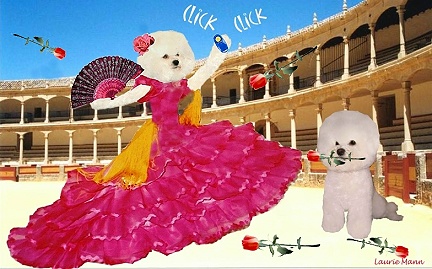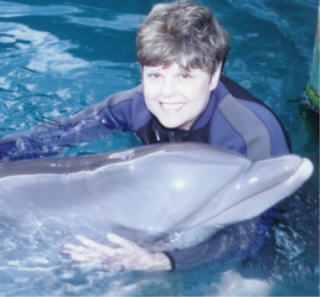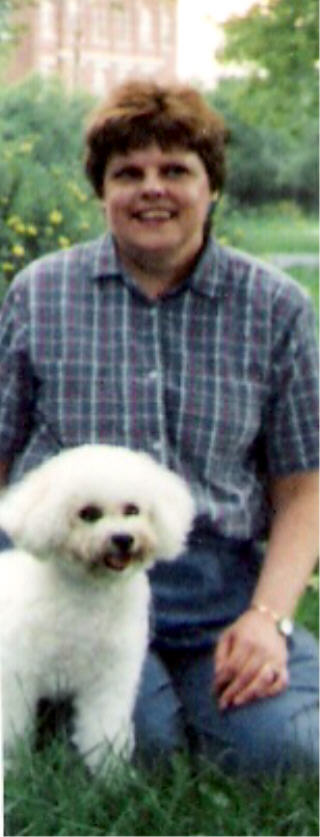Clicker training is a scientific method
based on the learning theories described in B.F.Skinner's "Theory of Operant
Conditioning". Back in the 1940's Skinner's students pioneered clicker
training and trained dogs,
cats, birds, mammals and other animals, including
many for the U.S. Defence Department. One of their numerous accomplishments
was to train pigeons to guide WW2 bombs.
In the 1960's, an astute and talented lady,
Karen Pryor, was challenged to train porpoises to perform a variety
of behaviors for marine shows at Sea Life
Park in Hawaii. Without collars and leashes, with only a whistle
and a bucket of fish, and by applying the laws of operant conditioning,
she was able to communicate with her porpoises, and control and shape truly
spectacular acts for Sea Life Park shows. Typically, all the marine acts
you see today have been trained this way. Marine trainers use
a whistle as a training tool, rather than a clicker, because the sound
of the whistle travels well in their marine training venue. Dog trainers
typically use a clicker.
Around 1992, Karen coined the phrase "clicker
training" in the dog world, as more and more dog trainers began to train
by adding behavioral methology to the art of dog training. By applying
the laws of operant conditioning, you can literally train any creature
that has a brain stem. Trainers have been highly successful in using this
training approach to train horses, cats, (both domestic and wild) birds,
rats, mice, pigs, cows, turtles, racoons,
elephants, rhinos, ferrets, mammals (including
killer whales and the fish in your fishtank at home), and countless other
species. More and more zoos are using clicker training to train their
animals to perform various
behaviors, including presenting their limbs
for Veterinary procedures. A gorilla can be trained to open his mouth for
a dental check. An elephant can be trained to present an ear through the
bars of his cage for a blood
sample to be safely taken. The applications
are endless. Many of the dogs on TV shows or in movies have been
clicker trained to perform the behaviors you see.
Several years ago, I was fortunate to be able
to attend a coveted two day clicker training seminar presented by Marian
Breland-Bailey PhD, who studied under Skinner, and Bob Bailey. Imagine
having the opportunity
of a lifetime to learn from these two highly
knowlegeable people who had trained more than 120 different species of
animals, and thousands of individuals. That weekend, we trained chickens!
What FUN that was!!!
A clicker, a handful of your dog's favourite
treats, and your Bichon are all you need to embark on an incredible journey.
Along the way, you'll discover how dog's learn, and how you can communicate
with your dog in a
language that he understands.
The clicker is an acoustic device. It's typically
a small handheld plastic box with a metal strip inside. When the metal
strip is depressed by a finger or a thumb, it makes a 'click' sound.
The sound is distinct, sharp
and crisp; it's unlike the sounds that your
dog typically hears in the run of a day.
Initially the 'click' sound holds no meaning
for the dog, however consider this: if everytime you click once,
you follow that click by giving your dog a treat that he loves, what do
you think will happen? Yes, you guessed
right! He'll quickly begin to associate the
click as predicting that a treat will follow. We clicker trainers call
that 'charging the clicker'.
The next step is to set up a training session
so that he can begin to discover that it is his behavior that causes the
click/treat to occur. Dogs are engaging in behavior all the time. The clicker
is used to mark and identify the exact behavior that will be reinforced.
Choose a simple behavior to begin with. Some ideas are to click when your
dog looks at you, or to click when your dog looks to the left, or to click
when your dog lies down, or to click when he play bows. Remember the deal
is a treat follows every click. With repetition, the dog will learn that
exactly what he was doing at the moment the click sounded will result in
a treat. Dogs do what works. Behavior that is reinforced will be repeated.
You'll know when he gets the idea as he'll begin offering you the behavior(s)
that he's been C/T'd for.
Be sure to be watching his behavior, and be
ready to click the slightest body movement towards that wanted behavior.
Timing is important when using a clicker to communicate and identify exactly
what will be clicked. Try to click AS the behavior occurs. Try to be quiet
and non verbal. The noise of you talking is as distracting to him as it
would be if someone was trying to talk to you while you were trying to
figure out a math question. Let
your clicker do the talking. Let him figure
the game out. Concentrate on observing your dog's body movements/behavior
so you can provide quick accurate feedback with your click. Smile. Relax.
Have fun capturing the behaviors you want repeated . Remember, you want
your dog to be successful. You want to build the want to play this clicker
game so concentrate on your timing of the click, your criteria and your
rate of reinforcement. The better timing you have with your click, the
quicker your dog will get the idea and the faster he'll learn.
Try to make it easy, clear and fun for him.
Make your expectations/criteria something your dog can succeed at so that
your rate of reinforcement will be high. You want him to get the idea that
he makes the click happen. You want him to begin deliberately offering
you the behavior(s) that you've C/T'd him for. You want your dog to want
to be an active, eager and willing participant in the training game.
Clicker trainers don't add the cue/command
to perform the behavior until after the dog has identified the behavior
he's been C/T'd for and is confidently offering it in training sessions.
Clicker training works for teaching new behaviors
as well as for changing unwanted behaviors. Rather than punishing unwanted
behaviors, clicker trainers use management to prevent unwanted behaviors
and they
teach/reinforce a behavior that is incompatible
with the unwanted behavior.
Clicker training is based on positive reinforcement
techniques to train behaviors. The dog is never 'forced' to do any behaviors.
The dog is free to experiment, and thus he is free to learn what works
and what doesn't work.
It's ideal to use for training dogs of any
age, including very young puppies so that they have the best possible chance
of growing up to be able to blend well into our human culture. There is
no need to wait until six months of age to begin training a puppy for obedience
trials, or anything else.
What I love most about clicker training is
watching the dog's eyes sparkle as they 'get' the game and become confident,
willing participants.
Written for Bichons Across Canada by Carole Mineault. Copyright 2006 Carole Mineault - All rights
reserved

![]()

![]()



